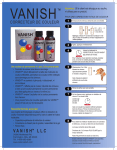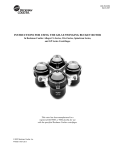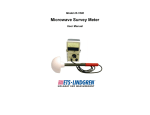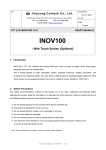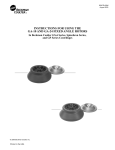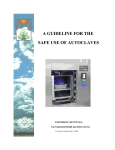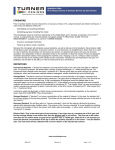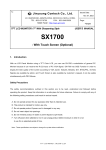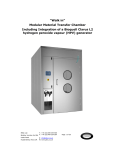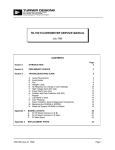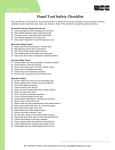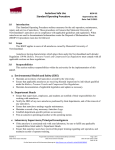Download Autoclaves - University of Michigan
Transcript
Laboratory Standard Operating Procedure for: Autoclaves Description This standard operating procedure outlines the use of autoclaves. Review this document and supply the information required in order to make it specific to your laboratory. In accordance with this document, laboratories should use appropriate controls and personal protective equipment when using autoclaves. Autoclaves are used to sterilize equipment through a process that incorporates high pressure and high temperature. Potential Hazards Autoclaves are such a common and familiar feature in many laboratories that it is easy to forget what hazards they can pose, including physical hazards (e.g. heat, steam and pressure) and biological hazards, (e.g. improperly autoclaved infectious materials). This guidance will provide practical information to be utilized by all researchers in the safe operation of autoclaves at University of Michigan - Dearborn. Individual labs are encouraged to use this policy as a guide for training new personnel on the safe use of autoclaves. Controls for different brands of autoclaves may have their own unique characteristics for loading, load sizes, cycle types and cycle settings. The type of materials to be sterilized will determine the sterilization cycle that will be used. For this reason it is important to read and understand the user’s manual for the specific model of autoclave that is being used prior to first time use. Always ensure that the user’s manual is readily available in case questions or concerns arise during the operation of the autoclave. Engineering Controls Autoclave monitoring and maintenance is an important aspect of a safe and properly functioning autoclave. Follow the manufacturer’s recommendations for preventive maintenance and ensure that all contractors hired to perform regular maintenance and repairs are approved by the manufacturer. Autoclave operators shall ensure that each autoclave is monitored as follows: Heat Sensitive Tape Monitoring – Operators shall use heat sensitive sterilization indicator tape for each load to indicate that the load has undergone an effective steam sterilization process. • • Note that this tape only indicates that the proper temperature for the cycle has been reached, but does not indicate that it was heated at the proper pressure or for the appropriate length of time. Ensure that the heat sensitive tape used does not contain a lead based indicator as this type of tape must be collected and managed as hazardous waste. Biological Indicators – Operators who autoclave medical/biohazardous waste need to do the following: 1 Revision Date: 4/1/14 • At least once a month use a biological indicator such as Bacillus Stearothermophilus (e.g. Prospore2) placed at the center of a load processed under standard operating conditions to confirm the attainment of adequate sterilization conditions. Work Practice Controls Do not autoclave items containing corrosives, solvents, volatiles or radioactive materials. Prior to loading 1. Before using the autoclave, check inside the autoclave chamber for any items left by the previous user that could pose a hazard. 2. Ensure that the drain strainer is clean before loading the autoclave. 3. Ensure that the door gaskets have not deteriorated, but are still intact and pliable. Loading 1. Load the autoclave as per the manufacturer’s recommendation. DO NOT overload the autoclave. 2. Liquids should be within a heat resistant plastic tray containing an inch of water. a. Bottles should not be filled more than 2/3. b. Keep 1-2 inches of space between bottles. 3. Individual glassware pieces should be within a heat resistant plastic tray on a shelf or rack and never placed directly on the autoclave chamber bottom or floor. 4. Make sure that the door of the autoclave is fully closed and latched and ensure that the correct cycle for the items being autoclaved has been selected before starting the cycle. Opening 1. Wear the proper PPE, including heat resistant gloves, lab coat, eye protection and close toed shoes when opening the autoclave door after a cycle. If there is a sharps hazard, wear cut resistant gloves. 2. When the cycle is complete, open the door slowly. Keep your head, face and hands away from the opening. When autoclaving liquids: 1. When running an autoclave cycle with liquids, the cycle time is longer but uses lower temperatures to minimize evaporation of the liquids. Liquid cycles also have a longer depressurization time to avoid “boil- over” of liquids. 2. To prevent bottles from shattering during the pressurization, the caps of containers with liquids must be loosened before loading. 3. Use only borosilicate glass (Pyrex™ or Kimax™) which can withstand the high autoclave temperatures. 4. Use a heat resistant “autoclave” tray with a solid bottom and walls to contain the contents and catch spills. 5. Wait 10 minutes after the cycle ends before removing autoclaved liquid load items. 6. Let the liquids stand for at least a full hour before touching with ungloved hands. Be sure to let others in the area know that a heat hazard is present. When autoclaving dry loads: 1. Add ¼ to ½ inch of water to the tray so that the bottles will heat evenly. 2. Check plastic materials to ensure that they are compatible with being autoclaved. 2 3. Before removing autoclaved items, wait 5 minutes after the cycle ends for loads containing only dry glassware. 4. For dry loads, let the glassware cool for a minimum of 15 minutes before touching it with ungloved hands. Protective Equipment (PPE) Wear the proper PPE, including heat resistant gloves, lab coat, eye protection and close toed shoes when opening the autoclave door after a cycle. If there is a sharps hazards, wear cut resistant gloves. Waste Disposal Place waste in a university approved autoclave bag; avoid overpacking of autoclave bags. Do not seal bags or close bottles and other containers tightly. After sterilization cycle, close and seal bag. The sterilized waste can be placed in a top box, sealed/taped and transported directly to the dumpster. Exposures/Unintended Contact If the employee is in need of emergency medical attention, call 911 immediately. Discontinue use immediately if an autoclave is not working properly. Post a sign alerting others not to use the autoclave. Mechanical failures need to be attended to by a trained technician. Contact the service company responsible for the maintenance of your autoclave or your department’s safety representative for further guidance. If you are burned, you should seek medical treatment immediately. Burns to the face, third- degree burns or burns over large areas of the body should be treated as emergencies. Call Public Safety at (313)593-5333 or 911 from a campus phone. Minor burns should be treated by using first aid procedures, including immersing the burn in cool water immediately, removing clothing from the burn area and keeping the injured area cool for at least 5 minutes. Regardless of the severity, notify your PI/Supervisor! Report all work related accidents, injuries, illnesses or exposures to WorkConnections within 24 hours by completing and submitting the Illness and Injury Report Form. Follow the directions on the WorkConnections website Forms Instructions to obtain proper medical treatment and follow-up. Complete the EHS Laboratory Incident and Near-Miss Report form. TREATMENT FACILITIES: Midwest Medical Center -- Campus Employees (including student employees) Mon-Fri 7:30 am - 4:30 pm 9301 Middlebelt Road Romulus, MI 48174 Phone: 734-941-1000 After hours - go to: Midwest Medical Center Open 24/7 4700 Schaefer Dearborn, MI 48126 Phone: 313-581-2600 3 Henry Ford Medical Center-Fairlane -- University students (non-life threatening conditions) 19401 Hubbard Drive Dearborn, MI 48126 Phone: 313-928-8278 Click here for more information. Report all emergencies, suspicious activity, injuries, spills, and fires to Public Safety by calling at (313) 593-5333 or 911 from a campus phone. Register with the University of Michigan-Dearborn Emergency Alert System. Training of personnel All personnel are required to complete the Autoclave Safety training online through MyLINC (Course BLS013w). All users shall be trained before operating an autoclave; the PI/Supervisor is responsible for ensuring that each person in the lab is appropriately trained. All training must be documented and the records maintained in the lab with other safety training certificates. The laboratory PI/Supervisor is encouraged to use this policy as a guide for training new personnel. Certification I have read and understand the above SOP. I agree to contact my Supervisor or Lab manager if I plan to modify this procedure. Name Signature UM ID # Date Prior Approval required – Is this procedure hazardous enough to warrant prior approval from the Principal Investigator? ☐ YES ☐ NO Principal Investigator Revision Date 4





